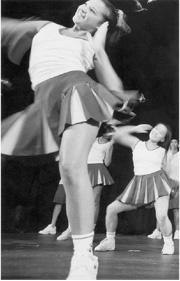A TRIED-AND-TRUE feature of women’s fashion magazines is the photo spread of clothing that’s guaranteed to make you look thinner than you really are. Certain designs and colors can slim the hips, elongate legs, and whittle waists. Even magazines like Mode, which claim to celebrate plus-size women, offer such illusory tips. At the same time, these magazines idolize models and pop stars in revealing outfits. What’s the lesson to be learned? Expose the bones, but hide your fat like a dirty secret.
BEAUTY
Eyre/Moore Gallery, ends December 22
So it’s refreshing, even a bit disarming, to see contemporary paintings of a fully exposed 250-pound model named Aviva. Her large figure, which recalls an ancient Mayan fertility doll, is glorified in Therese Stowell’s eponymously named oil series. In Aviva #4, the model lies on her side, her soft flesh folded like hills in a landscape. In #7, she stands upright, clutching her stomach like rising dough. Aviva # 5, painted in Warhol-esque orange and fuchsia, shows Aviva poised, in another confident stance, one hand beside her thigh.
“This is radical!” exclaimed one woman during the show’s opening night. Considering that most Americans are overweight, I wondered at the irony of her reaction. While we are barraged with media images of half-naked sticks, larger nude women are practically invisible.
Stowell’s work is bold, uninhibited, and without shame. It is, however, faceless. While her canvases are big—3 by 4 feet—they truncate Aviva’s figure, focusing on the sections between the shoulders and the thighs. The artist, a student at Goldsmiths College in London, is herself no plain Jane, with milky skin, high cheekbones, and hints of a young Ann-Margret. Yet, like so many women, Stowell confesses that she has been preoccupied with weight issues since junior high school. She says she omitted Aviva’s face because she wanted to make her model’s body “iconic and monumental.”
ICONS ARE USED to a different effect by another exhibiting artist, Angela Anderson, a Cornish College alum, whose paintings of women also deliberately exclude the face. Relying on familiar images from the 1950s, Anderson explodes the myth that beauty is special. A mouth full of crooked teeth is unique; beauty, on the other hand, is all about conforming. In Your Face Here, Anderson shows three mannequinlike figures that are identical save for their hair color. One’s a blonde, one’s a brunette, and the other a redhead, demonstrating that variety is rare (and undesirable) in a culture that idolizes uniformly busty but thin bodies.
While Anderson’s paintings are filled with pleasing pastel colors, her underlying message is dark. Her strongest piece is a painting that simply shows a pink bra set against a diamond wallpaper pattern. Below the bra are the words “Dream Date” written in white calligraphy. With those two innocent words, Anderson reflects the fears of real women: We must fill that C-cup to be loved. (Don’t believe me? Check out the stats from the American Board of Cosmetic Surgery: This year, over 100,000 women in this country received breast implants.)
The media is often blamed for upholding impossible standards of beauty. Yet who among us isn’t culpable? We like seeing good-looking people, and we recoil at imperfection: fat, acne, stained teeth, short legs, age spots, etc.
Beauty itself isn’t offensive. What is offensive is our exclusion of what we’ve come to consider ugly. And while the Eyre/Moore show doesn’t provide any answers or easy alternatives—where are the paintings of people with crooked teeth?—it’s a good reminder that we are much more than the sum of our (body) parts.







